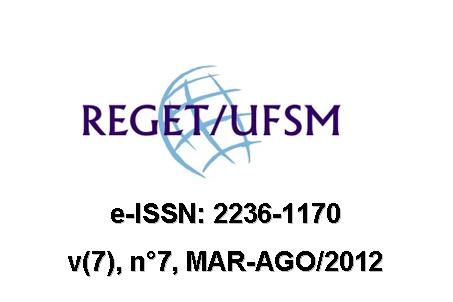AVALIAÇÃO AMBIENTAL CORRELACIONADA AO APROVEITAMENTO TURÍSTICO DO CAJUEIRO DE PIRANGI/RN: MEDIDAS DE CONTROLE E CONTINGÊNCIA
DOI:
https://doi.org/10.5902/223611705753Keywords:
Maior Cajueiro do Mundo, Turismo, Pirangi.Abstract
http://dx.doi.org/10.5902/223611705753
In Rio Grande do Norte, one of the hallmarks of this natural heritage is the cashew Pirangi, being amajor tourist destination in the state, is visited annually by people throughout the world who areattracted by the title of "World's Largest Cashew Tree." However, the cashew tree canopy hasbeen designed so prominent in the directions east/west, with branches spread over the asphalt,this behavior is explained by the position of the sun (east and west). However annual growthoccurs in all directions favoring impacts surrounding communities. As a way of supportingelements for discussion and technical aspects of preservation of cashew Pirangi-RN, this workdeveloped a technical survey of the main alternatives to redress the impacts of uncontrolledgrowth strong element of tourism in the region, seeking to maintain activity in the region. As well,we evaluate the main routes to preserve the cashew tree, showing aspects of pruning as one ofthe key points of how to behave with the same growth, without damaging the environment andmitigating the impacts of tourist activities in the region. The main points relate to the work thatpruning is the most appropriate method to contain the uncontrolled growth of the species and maintain this powerful element active region's tourism and that interventions must be wellplanned, especially with the choice of the appropriate periods for mitigate adverse effects oncashew.
Downloads
References
BARROS, L. M. CAJU. Produção: aspectos técnicos. Brasília: Embrapa Informação Tecnológica, 2002. 148p.
BARROS, L. M.; CRISÓSTOMO, J. R. Melhoramento genético do cajueiro. In: ARAÚJO, J. P. P.; SILVA, V. V. Cajucultura: modernas técnicas de produção. Fortaleza: EMBRAPA-CNPAT, 1995. p.73-96.
BIONDI, D. Diagnóstico da arborização de ruas da Cidade de Recife. 1985. 167f. Dissertação (Mestrado em Engenharia Florestal) – Universidade Federal do Paraná, Curitiba, 1985.
CEMIG. Manual de arborização. Belo Horizonte: Diretoria de Desenvolvimento do IEF, [1995], 23p.
CEMIG. Programa de compatibilização da arborização com a rede de distribuição de energia aérea. Belo Horizonte: Superintendência de Coordenação de Ações e Estudos sobre Meio Ambiente, 1994. 30 p.
CHIA, ROBERT. A ‘rhizomic’ model of organizational change and transformation: perspective from a metaphysics of change. British Academy of Management, v.10, 1999.
FERREIRA, F. A. Patologia Florestal: principais doenças florestais no Brasil. Sociedade de Investigações Florestais: Viçosa-MG. 570p., 1989.
IDEMA. Plano de ações emergencias da unidade de conservação integral “monumento natural cajueiro de pirangi”. Relatorio Técnico. 2009.
LEITE, V. D. et al. Gestão de serviços de limpeza urbana em cidades de médio porte. RGSA. v.4, n. 3, 2010.
LIMA, V. P. M. S. A cultura do Cajueiro no Nordeste do Brasil. 2. ed. Fortaleza: BNB-ETENE, 1998. n.3. 458p.
LUNA, J. V. U. Manual de fruticultura tropical. Circular técnica n.4. EBDA, Salvador, 1997. 91p.
MEDEIROS NETO, S. O. Relatório técnico de visita ao maior cajueiro do mundo. Natal, 2008. 18p.
MEDEIROS NETO, SOUZA. OLAVO DE, VAUDI ARAUJO DE, Relatório técnico de visita ao maior cajueiro do mundo. Natal, 2008. 18p.
MILANO, M.; DALCIN, E. Arborização de vias públicas. Rio de Janeiro: LIGHT, 2000. 226 p.
MOLINA, S. O pós- turismo. São Paulo: Aleph, 2003.
MOLINA, S. Pós-turismo: novas tecnologias e novos comportamentos sociais. In: MOESCH, Marutschka M e GASTAL, Susana (orgs.). Um outro turismo é possível. São Paulo: Contexto, 2004. pp. 25 – 31.
OLIVEIRA, V. H. C. Manual de Produção Integrada de caju. Fortaleza: Embrapa Agroindústria Tropical, 2005.
ROCHA, RODRIGO TAVARES DA; LELES, PAULO SÉRGIO DOS SANTOS; OLIVEIRA NETO, SÍLVIO NOLASCO DE. Arborização de vias púbicas em Nova Iguaçu, RJ: o caso dos bairros Rancho Novo e Centro. Rev. Árvore, Viçosa, v. 28, n. 4, ago. 2004 . Disponível em
<http://www.scielo.br/scielo.phpscript=sci_arttext&pid=S010067622004000400014&lng=pt&nrm=iso>. acessos em 01 jul. 2012.
SÃO PAULO. PREFEITURA DO MUNICÍPIO DE SÃO PAULO Manual Técnico de Arborização Urbana. Secretaria Municipal do Verde e do Meio Ambiente. 2012.
SEMARH. SECRETARIA DE ESTADO DO MEIO AMBIENTE E DOS RECURSOS HIDRICOS, SEMARH. Bacias hidrográficas do Estado do Rio Grande do Norte. Acessivel em: http://www.semarh.rn.gov.br. Acesso em: 30/06/2012.
SETUR. Dados turísticos do Rio Grande do Norte. 2011. Disponível em: http://www.rn.gov.br/. Acesso em 20/06/2012.
TOMAZZONI, E. L. et al. Turísticos com base nos conceitos de mudança, de incerteza e na teoria do caos: estudo dos exemplos de gramado e canela, na serra gaúcha. O&S - v.15 - n.47 Outubro/Dezembro – 2008.





